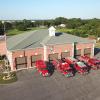When Diane Stollenwerk and Maggie McIntosh’s real estate agent first asked the house-hunting couple if they might like to see an old church, they said they’d look, but they weren't especially interested in buying a church.
And then they saw it.
“We absolutely fell in love with the church when we discovered the original façade from 1882 that, long ago, had been hidden by a drop-ceiling,” Stollenwerk said.
They said when they imagined removing the drop ceiling to reveal the original, exposed beams, it was breathtaking.
“To think of the possibilities of bringing that back into view as an internal feature, while outside preserving the beautiful and iconic look of the bell tower that was added in 1930” McIntosh said.
Built in 1865 on the corner of West Fourth and Park streets, St. Paul’s Methodist Episcopal Church in Lewes qualifies as a historically significant structure and as such, its exterior architectural features will not be significantly changed.
Church history
St. Paul’s parishioners were all black, reflecting a time when America’s churches were one of the most segregated places in the nation, a practice that remains little changed.
The Rev. Jerome Tilghman, pastor of the Methodist Church’s Lewes Charge, said St. Paul’s and other local properties the charge owns are being sold to consolidate holdings.
He said St. Paul’s had recently been used only on special occasions and rented for nondenominational services.
Tilghman said in 2005, John Wesley United Methodist on Plantation Road and St. Paul’s were placed on the limited service list, in part because they had become a liability, expensive to maintain, and inaccessible to people with disabilities.
St. Paul’s went on the market in early fall 2011, at an asking price of $370,000. In Jan. 2012, the Methodist charge put Faith Belltown United Methodist Church up for sale with an asking price of $519,000.
The church is on Route 9 near Five Points, a location listing agency Jack Lingo Realtor calls one that has commercial use potential.
The church conference plans to use sale proceeds to build a new church in a yet to be determined Lewes-Rehoboth Beach location.
Tilghman said in recent years, the Methodist Church as well as other denominations have been experiencing dwindling congregations.
“Folks dying off and the young folks moving away and not coming back,” he said.
The work ahead
Stollenwerk and McIntosh live in Baltimore and have been Lewes visitors for years.
Stollenwerk is a private healthcare consultant.
McIntosh is a delagate representing Maryland's 43rd District, which contains neighborhoods in Baltimore City and Baltimore County.
An active member of the Maryland Democratic Party, she first entered the House of Delegates in 1992 when she was appointed to fill a vacant position in the 42nd District.
She is a former Baltimore City Public Schools teacher, and is currently an adjunct professor at Catonsville Community College and the University of Baltimore.
It appears the church and its new owners are a match made in heaven.
“We decided we were going to preserve the integrity of the exterior and respect it,” McIntosh said.
Work on the church began in mid-August with builder Bob Parcell removing interior wall materials and getting a handle on the basement, which had sustained significant water damage.
Everything sodden was ripped out and Parcell set up a fan to begin drying the space.
“The building had been raised at some point. You can see where they added a couple courses of concrete blocks,” Parcell said, pointing out how newer blocks topped older.
The church’s hand-hewn, rock-solid floor joists are made of a type of red-colored wood Parcell thinks might be red oak.
Beefy, hardwood posts support the joists, and Purcell is adding new jack-posts because the floor needed additional support.
Above ground, the building’s walls need to be strengthened and insulated; new plumbing, electrical and heating, cooling and ventilation systems will be installed.
Except for a couple stained-glass windows, all windows and doors are being replaced with energy-efficient ones.
The existing hardwood floor will be kept, and the drop ceiling above the main portion of the sanctuary is coming out.
The owners are donating all pulpit woodwork to Lewes Historical Society.
McIntosh went before the Lewes Historic Preservation Commission to provide drawings, tell the panel about their plans, and find out what they had to do.
“They tried to approve the plans right then. I didn’t even have a builder. They were so excited,” she said.
The commission approved plans Sept. 17.
Getting a tax break
Joan Larrivee, Division of Historical and Cultural Affairs State Tax Credit Program Coordinator, visited the property recently to give the owners a detailed on-site assessment of what qualifies for Historic Preservation Tax Credit Program assistance.
Enacted in 2001, $30 million in tax credits are available for 10 years, with $3 million allocated each year.
Since its inception, the program has assisted in preserving and rehabilitating 25 historic buildings throughout the state, and it has generated more than $79 million in private investment tax credits.
The couple may apply for tax credit of up to $20,000 every two years.
Systems such as plumbing, electrical, and heating ventilation and air conditioning qualify for credit.
Larrivee told the homeowners to keep separate invoices for those jobs.
“We don’t mean to make more work for you,” she said. McIntosh, clearly excited about the tax program’s benefits, said providing separate invoices wouldn’t be a problem.
Larrivee explained how the program works and said the project might already qualify for money.
“Let’s say we spend the first $70,000 in the next month. Can we apply for credit and get it?” McIntosh asked. “Yes, absolutely,” Larrivee said.
“It’s terrific that we can get this investment back,” McIntosh said. She said they paid $300,000 for the property, but she isn’t certain about how much they’ll spend renovating it.
The women learned Lewes Mayor Jim Ford has extensive experience restoring historic buildings, and they asked for his opinions about the church.
“He was kind enough to look it over and talk with us,” Stollenwerk said.
She said for her 50th birthday last December, she wanted something odd.
“I told Maggie I want to go to Lewes, and I want to see what’s in the bell tower, because all we saw was this covered up crawlspace,” Stollenwerk said.
The hatch-like entrance into the bell tower is about two-stories up – there are no steps.
“The mayor said he’d bring his ladder over, but only if he could crawl in first. So, he went up there and said ‘I’ve had it,’ then I went up,” Stollenwerk said.
She found a couple relics in the bell tower: a partially disassembled gaslight, and a mostly intact basket that was probably used for church service collection.
She said later they posted a sign on the announcement board in front of the church.
“It said, ‘Happy Birthday, All Are Welcome, Come On In,’ and people wandered in. It was cool. I’d like to do that again when its finished,” Stollenwerk said.
“At this point we are still aiming for the work to be completed by the end of the year. We hope to be celebrating my 51st birthday and New Year's Eve there,” she said.
Editor’s note: We will follow and report on the church’s conversion and restoration as it progresses.




























































